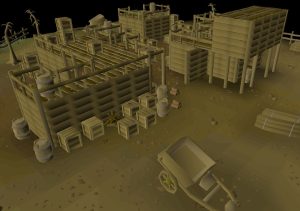The distribution of fencing materials is a complex industry that faces various financial challenges, ranging from market dynamics to technological changes. Distributors must navigate these issues to maintain profitability and ensure business continuity. This article discusses the multifaceted nature of these challenges and offers strategies for effectively managing costs, logistics, and risks within the fencing materials distribution sector.
Key Takeaways
- Understanding market dynamics, including raw material price volatility, trade policy impacts, and demand fluctuations, is crucial for fencing materials distributors.
- Implementing cost management strategies such as long-term supplier contracts, investing in cost-efficient technologies, and refining inventory management can enhance financial stability.
- Logistics and distribution challenges require optimizing transportation routes, managing cross-border distribution complexities, and employing advanced warehouse management solutions.
- Adapting to technological advancements through automation, data analytics, and e-commerce integration is essential for staying competitive in the fencing materials market.
- Mitigating risks and ensuring business continuity involves adopting insurance and risk management strategies, developing a responsive business model, and having a solid crisis management and contingency plan.
Understanding the Market Dynamics of Fencing Materials
Price Volatility of Raw Materials
The fencing materials market is highly sensitive to the price volatility of raw materials. Factors such as global demand, mining outputs, and currency fluctuations can lead to unpredictable costs. Steel, for example, is a primary component in manufacturing fences, and its price can significantly impact profit margins.
- Monitor global market trends
- Secure raw materials at fixed rates when possible
- Diversify supplier base to mitigate risks
Effective cost management is crucial to withstand the unpredictability of raw material costs.
The rebar industry, a key player in fencing materials, is particularly vulnerable. Suppliers must be agile, employing strategies to manage debt and remain competitive amidst economic pressures.
Impact of Trade Policies on Supply Chain
Trade policies can significantly alter the landscape of fencing materials distribution. Tariffs and import quotas often lead to increased costs and supply shortages. Distributors must stay abreast of policy changes to adapt quickly.
Regulatory compliance is crucial for maintaining smooth operations. Non-compliance can result in fines or disruptions, impacting the bottom line. Distributors should invest in compliance management systems to mitigate these risks.
- Monitor international trade agreements
- Assess the impact of new tariffs
- Develop alternative sourcing strategies
Effective trade policy navigation is essential for supply chain resilience. Distributors that anticipate and respond to changes maintain a competitive edge.
Credit and financing challenges impact lumber suppliers’ financial stability. Strategies include enhanced credit screening, clear payment terms, and diversifying the client base for risk management.
Demand Fluctuations in Different Markets
Market demand for fencing materials is as variable as the weather, influenced by regional construction booms, agricultural needs, and even local regulations. Understanding these fluctuations is crucial for distributors to maintain a steady supply without overstocking or shortages.
Seasonality plays a significant role in demand. For instance, demand may spike in spring and summer due to increased construction and agricultural activities. Distributors must anticipate these changes to align inventory levels accordingly.
Effective demand forecasting is essential for distributors to navigate market fluctuations and optimize stock levels.
Here’s a snapshot of how demand can vary across different markets:
- Residential construction projects
- Commercial development
- Agricultural sector needs
- Government infrastructure initiatives
Each market segment has its own rhythm, and savvy distributors will tune into these beats to keep their business humming.
Strategies for Cost Management
Long-term Supplier Contracts
Securing stability in an unstable market, long-term supplier contracts are a cornerstone of cost management. By locking in prices, distributors can shield themselves from the volatility of raw material costs.
- Predictability: Fixed prices over time ensure budget consistency.
- Relationships: Foster stronger partnerships with suppliers.
- Negotiation Power: Leverage long-term commitments for better terms.
Embracing long-term agreements not only mitigates financial risks but also solidifies supply chain reliability.
While beneficial, these contracts require careful drafting to ensure flexibility and adaptability to market changes. It’s a balancing act between securing favorable terms and maintaining the ability to respond to future market dynamics.
Investment in Cost-Efficient Technologies
In the competitive landscape of fencing materials distribution, investing in cost-efficient technologies is not just an option; it’s a necessity. By embracing modern solutions, companies can streamline operations, reduce waste, and ultimately lower costs.
Automation stands out as a transformative force. It minimizes manual errors and accelerates production timelines. Consider the following benefits:
- Enhanced precision in material cutting and assembly
- Reduced labor costs through automated machinery
- Improved energy efficiency with smart systems
Embracing cost-efficient technologies is a proactive step towards sustainable profitability.
Debt assessment is crucial for financial health. It involves a thorough financial analysis and strategic credit negotiation. For steel companies, a key material in fencing, this can lead to significant cost reductions. Effective strategies for debt recovery are essential, ensuring that funds are allocated efficiently and not tied up in high-interest liabilities.
Inventory Management Techniques
Effective inventory management is pivotal for fencing materials distributors. Streamline operations and reduce holding costs by adopting just-in-time (JIT) inventory systems. This approach aligns material orders with production schedules, minimizing excess stock.
Optimization of stock levels is crucial to avoid overstocking and understocking. Utilize inventory management software to track stock levels in real-time, ensuring a balance between supply and demand.
- Regularly review inventory turnover rates
- Adjust stock levels based on seasonal demand
- Implement cycle counting for accuracy
Inventory accuracy is not just about counting stock; it’s about understanding stock flow and making informed decisions.
Managing late payments is a challenge that extends beyond the fencing industry. It’s essential to have robust strategies in place for financial health and business success.
Navigating Logistics and Distribution Challenges
Optimizing Transportation Routes
Efficient transportation is the backbone of distribution. Optimizing routes saves time and slashes costs. Advanced mapping software and GPS technology are key tools in this endeavor, allowing for real-time adjustments and route planning.
- Analyze traffic patterns and historical data
- Consider alternative modes of transport
- Regularly review and adjust routes
Streamlining the transportation process is not just about finding the shortest path; it’s about smart logistics that adapt to changing conditions.
Suppliers can expedite the approval process by streamlining documentation, providing accurate information, and proactively addressing discrepancies to prevent delays. This proactive approach ensures a smooth distribution network, minimizing disruptions and maintaining a steady flow of fencing materials.
Dealing with Cross-Border Distribution
Cross-border distribution presents unique challenges for fencing materials suppliers. Navigating customs regulations and managing logistics across borders requires meticulous planning and execution.
Compliance with international trade laws is non-negotiable. Suppliers must stay informed about the latest changes to avoid costly delays and penalties.
- Understand import/export requirements
- Establish reliable logistics partnerships
- Invest in trade compliance software
Efficient cross-border distribution is critical for maintaining a competitive edge in the global market.
By optimizing these processes, suppliers can ensure timely deliveries and maintain customer satisfaction.
Warehouse Management Solutions
Efficient warehouse management is pivotal for fencing materials distributors. It’s not just about storing products; it’s about optimizing space and streamlining operations. Here are key solutions:
- Smart shelving systems to maximize storage density
- Real-time inventory tracking for accurate stock levels
- Automated picking and packing processes to reduce errors
Embrace technology to transform your warehouse into a dynamic asset. Advanced management systems can lead to significant cost savings and improved customer satisfaction.
Implementing these solutions can result in a more agile distribution network, ready to adapt to market changes and customer demands.
Adapting to Technological Advancements
Incorporating Automation in Operations
The integration of automation within fencing materials distribution is a game-changer. Efficiency gains are substantial, reducing manual errors and increasing throughput. Automation isn’t just about robots on the factory floor; it extends to software that streamlines order processing and customer service.
- Automated inventory systems predict restocking needs.
- Robotics handle material movement, cutting labor costs.
- AI-driven analytics forecast market trends, guiding strategic decisions.
Embracing automation positions distributors at the forefront of innovation, ensuring competitiveness in a rapidly evolving market.
While initial investments may be significant, the long-term payoff in productivity and scalability cannot be overstated. Distributors who leverage automation can expect to see a marked improvement in their bottom line.
Leveraging Data Analytics for Market Insights
In the competitive landscape of fencing materials distribution, data analytics stands as a pivotal tool. It enables businesses to dissect complex market trends and consumer behaviors, transforming raw data into actionable insights. By analyzing historical sales data, companies can forecast future demand and adjust their strategies accordingly.
Data analytics also aids in identifying the most profitable customer segments and tailoring marketing efforts to maximize ROI. Distributors who harness the power of analytics can stay ahead of the curve, ensuring they meet the market’s needs efficiently and effectively.
- Predicting economic impacts
- Innovating payment models
- Emphasizing sustainability
With the right analytics approach, distributors can streamline operations, reduce waste, and optimize their supply chain.
The Role of E-commerce in Fencing Materials Sales
The shift towards online sales channels has revolutionized the fencing materials industry. E-commerce platforms offer unparalleled convenience, expanding customer reach beyond traditional geographic limitations. With a few clicks, customers can compare products, prices, and suppliers, making informed purchasing decisions.
E-commerce not only simplifies the buying process but also streamlines the sales cycle, reducing overhead costs. This digital transition is not without challenges, however. Navigating payment disputes in specialized markets and assessing international credit risks are part of the new landscape.
Embracing e-commerce requires a robust digital infrastructure capable of handling complex transactions and providing secure payment options. Utilizing blockchain technology can enhance payment security, fostering trust with customers.
The table below outlines the impact of e-commerce on sales and customer engagement:
| Metric | Pre-E-commerce | Post-E-commerce |
|---|---|---|
| Sales Volume | Moderate | High |
| Customer Reach | Local/Regional | Global |
| Sales Cycle | Longer | Shorter |
| Overhead Costs | Higher | Lower |
Mitigating Risks and Ensuring Business Continuity
Insurance and Risk Management Strategies
In the fencing materials distribution industry, risk management is a cornerstone for stability and growth. Diversifying the client portfolio is essential to mitigate the impact of defaults and ensure a steady revenue stream.
- Evaluate default severity to gauge potential financial impact.
- Maintain open communication with clients to preemptively address payment issues.
- Utilize collection agencies or legal recourse as a last resort.
Reserve funds and comprehensive insurance policies are critical safety nets. They provide a buffer against unforeseen events, ensuring business continuity. A well-structured insurance plan can cover a range of scenarios, from property damage to liability claims.
A proactive approach to risk management can safeguard against financial upheavals and foster long-term business resilience.
Developing a Responsive Business Model
In the competitive world of fencing materials distribution, resilience is key. A responsive business model is not static; it evolves with market conditions, customer needs, and internal capabilities. To achieve this, companies must:
- Diversify their client base to spread risk
- Invest in robust quality control systems
- Adopt flexible business strategies that can pivot as needed
Proactive debt collection and clear contracts are essential to mitigate the risks of client defaults. These practices ensure a steady cash flow and protect the bottom line.
A responsive business model anticipates change and adapts swiftly, ensuring that the company remains competitive and can seize new opportunities as they arise.
By focusing on these areas, businesses can build a model that not only withstands market pressures but also thrives amidst them. The goal is to create a system that is agile, efficient, and ready to meet the future head-on.
Crisis Management and Contingency Planning
In the volatile world of fencing materials distribution, preparedness is key. Distributors must have robust contingency plans in place to swiftly navigate through unforeseen events.
- Establish clear communication channels
- Regularly update emergency protocols
- Train staff for crisis response
Effective crisis management minimizes downtime and maintains customer trust.
Financial resilience is crucial for weathering storms. Distributors should explore diverse financing options to ensure liquidity. This includes efficient invoicing, leveraging tech automation, setting clear payment terms, fostering strong customer relationships, and considering alternative financing to support growth.
In today’s volatile market, mitigating risks and ensuring business continuity are paramount. At DCI, we specialize in providing expert debt collection services tailored to the Building Materials Industry. Our commitment to detailed, customized solutions means your business can navigate financial challenges with confidence. Don’t let outstanding debts disrupt your operations. Visit our website to request a personalized quote and learn how we can support your business’s stability and growth. Your information is secure with us, and our team is ready to assist you with all your debt collection needs.
Frequently Asked Questions
How can fencing materials distributors manage the volatility of raw material prices?
Distributors can manage price volatility by engaging in long-term contracts with suppliers, diversifying their supply base, using financial hedging strategies, and maintaining a strategic inventory to buffer against price fluctuations.
What impact do trade policies have on the fencing materials supply chain?
Trade policies, including tariffs and trade agreements, can affect the cost and availability of fencing materials. Distributors need to stay informed about policy changes, seek alternative sources, and consider local or regional suppliers to mitigate the impact.
How can distributors adapt to fluctuations in market demand for fencing materials?
Distributors can adapt to market demand fluctuations by analyzing market trends, maintaining flexible inventory levels, and developing a diverse product range to cater to different market needs.
What are some effective inventory management techniques for fencing materials?
Effective inventory management techniques include just-in-time delivery, demand forecasting, use of inventory management software, and regular inventory audits to ensure optimal stock levels and reduce holding costs.
How does e-commerce affect the sales of fencing materials?
E-commerce provides an additional sales channel, broadens the customer base, and enhances customer service with online ordering and tracking. It also introduces new competition and requires investment in digital marketing and logistics.
What strategies can fencing materials distributors employ to ensure business continuity?
To ensure business continuity, distributors should invest in comprehensive insurance, develop risk management strategies, create a responsive business model that can adapt to market changes, and have a solid crisis management and contingency plan in place.





